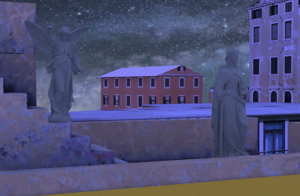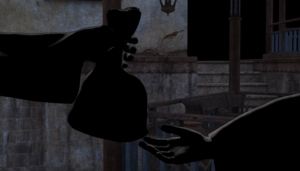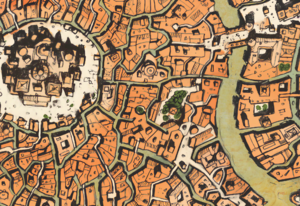
Al'Adeaf (founded as Denaria, after Waukeen) is a an ever-sinking city and trade hub in the central Pteris area, linking much of the southern and northern parts of the continent together in commerce and culture. It was the second largest of The Seven Cities, a loose federation of cities in central Pteris.
Citizens from Al'Adeaf are often called `Sinkish people.
History[edit | edit source]
A City of Statues (999 PR)[edit | edit source]
Almost a thousand years ago, the “city” of Denaria was nothing more than several dozen squalid huts perched on a few islands in the fine granular sands of the Delta Serpentine. The city’s most worshiped goddess, Waukeen, soon pushed the mountains aside to provide large, flat, and fertile land for settling. Times have changed: close to 100,000 people dwell here now and the population soars during festivals or major market days. Long since renamed Al'Adeaf (Trudgeon for "Ever Sinking") the city looks westward onto a the dangerous and mysterious Badlands of Pteris, and still stands by its merchant goddess who promotes trade and profit. Al'Adeaf is the second largest city of The Seven Cities, a trade union formed by several cities on the Pteris continent and wields unmatched economic power among the seven.

In Al'Adeaf, the ringing of bells occasionally drowns out the din of endless hammering and the cries of merchants hawking their wares. Pennants of golden sandblasted coins (depicting a white Aarakocra) flutter from rooftops and poles. Priests and merchants are everywhere, statues adorn every building in sight, wild animals burrow and crawl on and beneath hundreds of stone or wooden bridges, and brightly painted buildings with breathtaking architecture ignominiously stand half-sunken into the sand. Say what you want about the heat or the smell, it’s a memorable and beautiful city.
About[edit | edit source]
The Sanctity of the Markets Curse[edit | edit source]
While some cities dealt with curses like Perpetual Darkness, Al'Adeaf had a special boon (or curse depending on if you're a spellcaster or not) which was an attempt to keep anyone from using magic to manipulate this holy site of trade and commerce. More can be read on the page linked above, but the general gist is that any magic or spells cast within city limits would cause bouts of Corruption, which meant that the magic would still work, but would leave permanent and visible marks and traces, which took many forms. This alone kept many spellcasters from even attempting to visit Al'Adeaf, since sometime the corruption could affect their person.

Laws & Traditions[edit | edit source]
According to the laws, it was legal to burn down an abandoned building if there was sufficient reason to believe that it was haunted.
The People[edit | edit source]
Al’Adeaf is full of families who have immigrated over many centuries, often intending to visit for a few weeks and choosing to settle there instead. Appearance varies amongst the population, with taller stature and darker skin tones prevailing in Al’Adeaf’s oldest families, physical traits passed down from the ancient Snobbite Regality. A good number of 'Sinkish, however, carry the traits of the northern Hobgoblins, including orange-red skin, large ears, and stout faces. Al’Adeaf takes great pride in considering itself cosmopolitan — the citizens may pay close attention to the appearance of wealth and social class, but discrimination based on race, color, or gender is considered heretical by the church and is strongly discouraged by the community.
‘Sinkish organizations tend towards a matriarchy, especially in the church; as a rule of thumb in Al’Adeaf, women are in positions of prestige and power as much as or more than men.
Guilds[edit | edit source]
- There was at least one proper Thieves' Guild in the city, run by a middle-aged criminal named Belto before his death at the hands of a penanggalan. Their special market was the repackaging and smuggling of numerous poisons and tonics.
- The Fisherman's guild operated out of Fish Hall in the city was actually run by a sorcerous cabal, which used dark magic (and literal human sacrifices) to appease the god of Poseidon and bring bountiful desert fish to the surrounding quicksands of the city. One life to feed a hundred thousand.
Societies[edit | edit source]
Like the similarly ghost-filled city of Ahol, Al'Adeaf could be broken up into important factions which each ran different parts of the city. It was possible for heroes living in or visiting the cities to have either positive or negative relationships with these groups, which could wildly influence how much help (or hinderance) they found as they went about their business in the busy streets.
The most prominent factions included:
- Ancient Snobbite Nobility: Dissolute but infinitely proud, clinging to their social graces and ancestral superiority within their crumbling mansions.
- Church of Waukeen, goddess of Commerce: every exchange of money is a prayer to her sly wisdom and obsession with trade that defines the city itself. Her priests are moneylenders who hunt down Sorcerers and carry out her will.
- The Church also kept a small cavalry of Inquisitors, which were similar to something like the Spirit Wardens.
- City Watch: these poor bastards are under-funded, under-respected, and the hardest working employees in Al’Adeaf. They’re responsible for enforcing order, solving murders, and bringing the guilty to the gallows.
- Commoners: no one remembers the underclass, but the commoners look out for their own, and there’s a lot more poor in Al’Adeaf than there are nobles. A terrifying force when roused.
- The Guild of Architects and Canal-Watchers: despite rumors that guildmembers often die young from disease and injury, this powerful guild ensures Al’Adeaf’s architectural stability, and thus enjoys significant political sway within the city.
- Mercanti: The new-money nobility of Al’Adeaf, church-blessed families whose iron grip on specific guilds brings in the trade that powers the city.
- Mercenaries (including House Armies): Hard-living professional warriors who stay loyal as long as their pay doesn’t run out, mostly Hobgoblins.
- Includes a group known as "Bully Brugs Contracted Keepers and Killers"
- Monstrosities: Most people have never seen one, but there are rumors that a loose community of serpentine folk live underneath Al’Adeaf. They’re unlikely to have Waukeen’s best interests at heart.
- Badlanders: an unorganized and unpredictable group of barbarians, travelers, tourists, professional adventurers and piratical scoundrels seeking some quick coin, coming mostly from the badlands out west.
- The Sorcerous Cabal: Sorcery is considered inhuman, unnatural, and antithetical to the grace of the goddess Waukeen. If one or more sorcerous cabals exist, they’re a threat to everything right-thinking people love.
- Thieves’ Guilds: Avoiding taxes is a mortal sin in the eyes of the goddess Waukeen, but making money is a blessing, so it’s fair to say the dozens of smugglers’ and thieves’ guilds are conflicted at best.
- The Seven Cities: Distant rulers of not just Al’Adeaf, but Ugarat and 5 other cities in central Pteris, the secret police, and the vast government bureaucracy of committees that keeps the city functioning as well as it does.

Architecture[edit | edit source]
Like all of the The Seven Cities, Al'Adeaf was connected to the greater network of cities via an Iron Horse sometime around 700 PR, the main train station was located in City Center.
The Statues[edit | edit source]
The most notable feature of Al'Adeaf's architecture is the unimaginable number of Funerary Statues dotted across the rooftops, porches, balconies, alleyways, and sometimes even right in the streets.
The Cityscape[edit | edit source]
The city is full of color. It’s a jumbled mess of stone spires, wooden shacks, brightly painted manor houses, grand open plazas, teeming marketplaces, roof gardens, harbors, and soaring bridges over omnipresent canals. The tallest noble towers are decorated with ancient jeweled windows of breathtaking beauty, but that doesn’t necessarily distract from the unevenly sinking hovels of the poorer districts that house many common families in a small amount of space. There are even a few remaining buildings above ground from ages of sorcerous wonders, made from unbreakable crystal or other unspeakably beautiful substances.
Al’Adeaf's architects have a taste for the classical. Columns project strength, and strong foundations distract from sinking edifices. Among the clean lines are overwrought gothic windows accompanied by exquisite stained glass. The Aarakocra motif is everywhere, jumbled in among gargoyles and thousands upon thousands of funerary statues. Embossed Aarakocras decorate stone pathways between marketplaces, enormous stone aarakocra statues grace the apex of Mercanti rooftops, and Commoners scratch Aarakocra into their shacks hoping for a small taste of Waukeen's Blessing.
With land at a premium, locals take advantage of height. Laundry lines dangle from rooftops 80 feet in the air. The outsides of solid stone towers become a warren of rickety wooden ladders, hand-built platforms, and cantilevered walkways as people try to conjure up more space from thin air. Too many Commoners live in these precariously placed wooden shacks, hoping not to crash to the ground during one of the many storms that sweep in from the ocean. Similarly, there are those who take advantage of depth. Those with the least coin often live in moldy and leaking sub-basements below ground, clambering up five or six stories each morning just to reach street level. Collapses, floods, and fires in such dwellings are usually deadly.
Public and private gardens are a symbol of wealth and power. Those who can afford it prefer roof gardens of rare and exotic flowers, but you’re likely to come across small hidden (and well-defended) vegetable gardens grown on other people’s roofs by those who need the food most. Hedge animals are currently fashionable on the estates of the rich; hedge mazes are so last generation. More than one small island is entirely given over to public gardens, with any building within their borders deemed illegal.
The Undercity[edit | edit source]
Buildings normally lose about 8 cm to the sink each year, or roughly one floor per generation, but a sudden sink is not an unheard-of phenomenon; if you’re tremendously unlucky, a laundry line a comfortable story up today might lie on the ground tomorrow. Sinking buildings add complications, with sidewalks of varying heights and stairs leading up to (or down to) a building’s current front door. Architects work constantly to repair, modify and reinforce buildings.
All but the most recent buildings reach deeper underground than they do vertically above street level. Descending through usually flooded basements brings you back through the building’s history one generation at a time. Many such levels are flooded with quicksand, but sometimes good drainage, airtight construction or ancient pumps keep most of the sand out. Anything might be forgotten down there, and it isn’t unusual to discover that your supposedly secure basements are being used as an underground highway by smugglers. Paranoid homeowners pay architects to seal off their basements and then live in a state of denial, trying to forget that those basements even exist.
The Under-Undercity[edit | edit source]
Even deeper than the underground floors of buildings are those places that are so far gone that nature itself has begun the reclamation process. If you go deep enough under Al'Adeaf, you eventually reach underground caverns and passages that are claimed by the Mercan (Mer-sehn) people, a serpentine race with connections back to ancient prehistoric Quelmar. It is in these underground dens that Al'Adeaf's greatest and most ancient enemies lurk: The Serpentine.
Districts[edit | edit source]
The Tangle[edit | edit source]
Al'Adeaf's working class neighborhood full of close-knit, tight-lipped commoners. The buildings are for the most part rebuilt from ships which crashed and sank into the quicksand, propped up and used as shelters. It took twice as long to navigate through the Tangle as it did other districts.
- Noble House was located in the Tangle. It's easily recognizable in the stonecutters' neighborhood as it is carved out to be almost identical to a similar mansion in the Alderhall district, it was a mockery of that family's mansion as Noble House was carved and built by disowned members of the Valori family.
Alderhall[edit | edit source]
The rich district, home to such places as the PussyCat Club (see below).
City Center[edit | edit source]
Sag Harbor[edit | edit source]
Ironcross[edit | edit source]
Upper middle class to lower upper class. It is the most northern district.
Harbor Approach[edit | edit source]
The northwest harbor of the city, it was primarily filled with shipping warehouses and ocassionally a mansion belonging to one of the city's merchant class. It was a center of smuggling in and out of the city, and the guards who worked the district were often as corrupt as the criminals that lurked there.
Notable Locations[edit | edit source]
The Beggar's Bodega[edit | edit source]
The Tangle Bazaar[edit | edit source]
The Tangle Bazaar, located just south of the Beggar's Bodega, thrives as a bustling hub of commerce and social interaction, especially within the vast khan that anchors the marketplace. This khan, known for being the largest in the bazaar, stands prominently on the east side of the main thoroughfare, easily directed to by any local. Its structure boasts two floors surrounding an enclosed courtyard, complete with a fountain that serves as a centerpiece for the dynamic exchange of goods, stories, and culture.
The ground floor is a hive of activity, with large rooms opening onto the courtyard for merchants to store and sell their wares. Two staircases flank the entry hall, leading up to a balcony that encircles the courtyard, with smaller rooms on the second floor available for rent by travelers or merchants. The atmosphere is vibrant, marked by the comings and goings of people, the unloading and loading of donkeys and horses, and the myriad transactions and interactions that define the bazaar's pulse.
By night, the outer door of the entrance hallway is closed and barred, with a guard stationed to oversee the premises. He permits entry only to those who have rented a room, offering conversation and insights into the khan's inhabitants to those who befriend him.
Visitors find the Tangle Bazaar khan a place of endless fascination, whether they come to shop, browse, or simply enjoy the lively atmosphere by the fountain. For those looking to blend in or investigate the depths of the khan's secrets, the day demands a careful navigation of crowds and a keen eye to avoid detection, while the night offers its own challenges and opportunities for those daring enough to explore its shadows.
The Book Bazaar[edit | edit source]
A little lending library and research post at one point run by a lovely old woman named Lavinia.
Denford Boarding School[edit | edit source]
A school built in 904 PR for a small number of students, when Al'Adeaf was only a little more than a town, ran by Amabel Denford who died at the hands of her student Jospeh Watts. The school continued to sink out in the Tangle and took on the reputation as a haunted house. Was burned down in 999 PR.
The Burj Al'Adeaf[edit | edit source]
A massive 7-star hotel located in the City Center, the Burj Al'Adeaf was only just recently built in 999 PR, and had over 40 floors of rooms for anyone wealthy enough to afford the awe-inspiring views of the surrounding city and dunes. A single-bed room could cost over 1350 gold a night. Often the bed of choice for any number of Snobbite princes who visit or stay in the area. The only access to the hotel was via a private bridge, which led into its massive 60 foot high atrium which was ornated with 22-carat gold fountains. Each room also had its own dedicated member of the staff to serve to it.
PussyCat Club[edit | edit source]
Having opened on 10/2/984 PR, the Pussycat club was located in the Alderhall precinct on Kettle Road. It opened with a boisterous opening ceremony fundraiser which was meant to benefit the veterans of the ongoing War of Many Names. The Club was full of gambling opportunities and was the largest casino in the city upon opening. When asked about it, the manager Peter Lankila (a secret vampire himself) said:
This is a new foundation of gaming and leisure in the heart of Al'Adeaf, and they provide so much benefit to the community here, and we wanted to latch on to that as we open the new facility and being part of giving back to the community in Flaughtland
There is also live entertainment and a bar on the second floor of the casino. The public bottom floor has a capacity for nearly 100 gamblers at a time, and the casino itself only opens after 8:00 PM every day (partially to accommodate the secret vampire running the place)
However, one floor BELOW the bottom floor was the secret basement, which was only accessible from a hidden elevator inside the Casino's vault, in the basement, the owner Lankila kept countless coffins and tombs which held his vampire thralls, as well as one large ornate coffin for himself to sleep in during the day.
Apswitch's Market[edit | edit source]
The oldest market in Al'Adeaf.
The Den of Smoke[edit | edit source]
A popular opium den located in the Tangle.
Al'Adeaf University[edit | edit source]
Founded in 691 PR
The most prominent of higher education institutions in Al'Adeaf. Here, new ideas are debated and alternative ideologies are lived. There was also the Pulverfass Pub on site which was THE place for students to go drink after their studies. It was known as a hole in the wall bar that served not just normal alcohol, but also some more chemical brew.
The "Luskin Fretray Convant" was an endowment-funded academic fraternity that provided scholarships for worthy students. It had a frat house just outside of City City, on the edge of Throner Park. It was mostly a chemistry student frat, but some biologists, physicists and even mathmematicians took part in the activities. It was largely financed by the Julius Sawback Foundation, the nonprofit arm of the Julius Sawback LP. They gave out scholarships to the frat members, but required the students to maintain both high academic standards and an impeccable social reputation, which is why some students would lose their scholarships when caught drinking too much (likely at the Pulverfass).
AgraWealth Industries[edit | edit source]
An R&D firm looking for solutions to growing crops in the deserts of Pteris, had a very close connection to The Seven Cities. At one point in time came into direct competition with Lich Omoi when they hired adventurers to steal his hydra-hydrangea, a plant that grow more with every "head" you cut off. They had both a main lab, which they shut down, and "Site B" where they kept their most experimental and dangerous experiments, including the hydra-hydrangea. In addition to the labs, they kept a business office in City Center, which was described as "aggressively dull and anonymous, like tofu that's absorbed the flavor of surrounding spy agencies"
AgraWealth had deep pockets thanks to connections to the great Seven Cities.
Marano's[edit | edit source]
A famous storefront in Harbor Approach that used spices, salts, and vinegars to make some of the best pickles in the city. It was run by a married couple (Lara and Sialia Marano) but after their arrest and disappearance, it was taken over by a Marano cousin.
Fish Hall[edit | edit source]
Guild hall of the combination Fisherman's Guild and Sorcery Cabal. The Hall also doubled as a church to Poseidon.
Behind the Screen[edit | edit source]
- Staying in line with the source material, many NPCs in Al'Adeaf had vaguely Italian fantasy names (ie Oscar Ghilardi, Solocone Verdi, Gaudenzio Netti)

